Welcome to the electronic version of Storyknife. Sign up to receive the Storyknife eNewsletter via email.
A Good Plan Is One Step Toward Success
Donlin Works To Finalize Plans For Dam Safety
Storyknife, July/Aug. 2019 edition
This article provides an introduction to mine tailings and how they are managed. Future articles will focus on how the Donlin Gold project is being designed to prevent problems that have occurred at mines developed without our strict laws and processes.

The next few years are a pivotal time for the Donlin Gold project to finalize a key aspect of developing a responsible mine in our Region: the storage and handling of tailings.
Donlin Gold offers major economic opportunities for Calista Corporation and our Shareholders in the YK Delta that won’t come to fruition without a comprehensive plan to manage tailings—the material left over after the gold is extracted.
Large hard rock mines typically produce fine-grained tailings that must be put in a stable, permanent location. Accomplishing this requires extensive testing and engineering, a thoroughly reviewed plan, careful construction, and active and ongoing oversight.
It is important to Calista that Shareholders, Descendants, and other YK Delta residents have the facts about best practices for the storage and management of mine tailings. Our priority is to protect Shareholders and employees while creating social and economic opportunities.
WHAT SHOULD DONLIN DO WITH ITS TAILINGS?
The best method to store tailings varies from mine to mine. It’s a matter of designing a method that will work best for a specific location.

Tisha Kuhns, Calista Corp. Geologist and Interim VP of Lands & Natural Resources
“Donlin’s tailings management plan, which is being designed with Calista’s active input and support, is aligned with the best, up-to-date practices known in the mining industry,” says Tisha Kuhns, Calista Interim Vice President of Lands and Natural Resources, and a geologist by training.
A lot of important factors are considered before establishing a tailings management plan that best protects the local environment. These factors include the chemistry of the orebody, the local topography, the bedrock, groundwater, and the water content of the tailings.
If the tailings are coarse-grained, best practice may be to remove as much water as possible and “stack” the tailings in large piles, as is done at the Greens Creek Mine in Juneau. However, Donlin’s tailings will be fine-grained, like silt.
Due to the large volume of ore that will be processed—59,000 tons per day—it will be virtually impossible to fully extract the amount of water necessary to use the dry stack method, says Dan Graham, Permit and Environmental Manager for Donlin Gold.
The topography at the Donlin deposit is favorable to building a single dam that permanently entraps the tailings in a valley, according to Graham. The tailings would be drained during storage and covered with rock, soil and vegetation at closure.
The dam would be continually inspected and regulated by the State of Alaska and actively monitored by staff from Donlin Gold and Calista. We hope Shareholders will be part of the monitoring teams.
“Alaska’s Dam Safety Program has a track record for strict diligence in regulating dams under its jurisdiction.” – Tisha Kuhns, Calista Corp. Geologist and Interim VP of Lands & Natural Resources
Over time, the tailings are expected to consolidate and solidify to the point where the dam would cease to exist, and the tailings and dam together would just become part of the landscape. If not, the dam would be regulated by the State of Alaska and monitored by Donlin Gold and Calista in perpetuity.
A LENGTHY TIMELINE
Donlin Gold received its first set of significant project approvals last summer after a detailed six-year federal environmental review process. The approvals were based on a development alternative for Donlin selected as the “least environmentally damaging and practicable” by the federal government.

Dan Graham, Donlin Gold Permit and Environmental Manager
The alternative selected by the federal government included storing tailings behind a rock-filled dam, but it did not give final approval for the design or construction of the tailings dam or related facilities. The Alaska Department of Natural Resources (DNR) runs a comprehensive four-step process that regulates the design and operation of dams. This process starts with an initial application, then a preliminary design, a detailed design, and finally, a package of construction-ready drawings and manuals.
Donlin Gold is in the second step of this process and is working closely with Calista over the next year to finalize its preliminary design. It will be at least two years before the project receives a decision from the State on certificates approving dam design and construction.
UNIQUE REGULATORY PROCESS
Getting approval to operate a large dam is a rigorous engineering process, with independent, third-party experts assigned to review and weigh in on the many technical documents that are involved.
Two other tailings dams—at the Red Dog and Fort Knox mines—are regulated by DNR’s Dam Safety Program, which also regulates significant water dams.
“Alaska’s Dam Safety Program has a track record for strict diligence in regulating dams under its jurisdiction,” Kuhns says.
PUBLIC ENGAGEMENT
In the coming year, Shareholders and other community members will have a new way to engage with the Donlin Gold project.
Donlin Gold, Calista and The Kuskokwim Corporation will begin the process of establishing advisory committees that will focus on environmental and other issues. Serving on these committees will be an opportunity for leaders in the Region to exchange information and share concerns and ideas with representatives from Donlin Gold, Calista and The Kuskokwim Corporation.
The scope of work for these committees is still under development, but it is very important to Calista that they will address protection of our environment and our subsistence way of life.
In the coming year, Donlin Gold, Calista and The Kuskokwim Corporation will begin the process of establishing advisory committees that will focus on environmental and other issues.
Calista is committed to sharing the latest facts and details with Shareholders. Having information about topics like tailings is important for those who want to learn about the proposed mine and provide their traditional knowledge to ensure the protection of our land and resources. Quyana from Calista Headquarters.